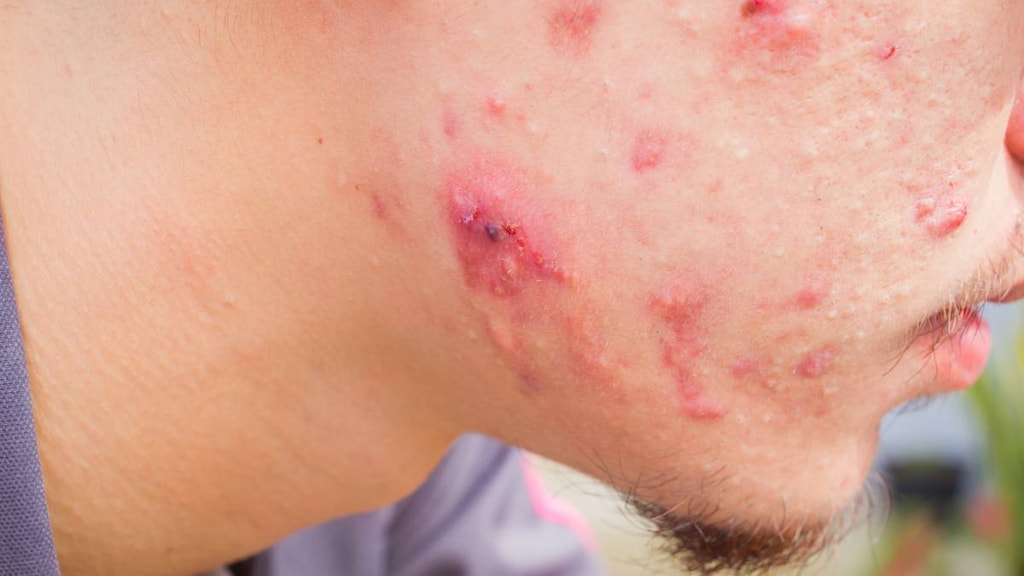Dosage Forms
Excipient information presented when available (limited, particularly for generics); consult specific product labeling.
Gel, External:
Epiduo: Adapalene 0.1% and benzoyl peroxide 2.5% (45 g) [contains edetate disodium, polysorbate 80, propylene glycol]
Epiduo Forte: Adapalene 0.3% and benzoyl peroxide 2.5% (45 g, 60 g) [contains edetate disodium, polysorbate 80, propylene glycol]
Generic: Adapalene 0.1% and benzoyl peroxide 2.5% (45 g)
Pharmacology
Mechanism of Action
Benzoyl peroxide releases free-radical oxygen which oxidizes bacterial proteins in the sebaceous follicles decreasing the number of anaerobic bacteria and decreasing irritating-type free fatty acids.
Adapalene is a retinoid-like compound which is a modulator of cellular differentiation, keratinization, and inflammatory processes, all of which represent important features in the pathology of acne vulgaris.
Pharmacokinetics/Pharmacodynamics
Absorption
Via the skin
Metabolism
Benzoyl peroxide: Converted to benzoic acid in skin
Excretion
Adapalene: Primarily through bile; Benzoyl peroxide: Urine
Use: Labeled Indications
Acne vulgaris:
US labeling: Topical treatment of acne vulgaris in patients 9 years and older (Epiduo) or 12 years and older (Epiduo Forte).
Canadian labeling: Topical treatment of mild and moderate acne vulgaris, characterized by comedones, inflammatory papules/pustules in patients 9 years and older (Tactupump) or treatment of moderate and severe acne vulgaris characterized by comedones, inflammatory papules/pustules with or without occasional nodules in patients 12 years and older (Tactupump Forte).
Contraindications
There are no contraindications listed in the US labeling.
Canadian labeling: Hypersensitivity to adapalene, benzoyl peroxide, or any component of the formulation; application to areas of skin affected by eczema or seborrheic dermatitis; pregnancy or planning to become pregnant.
Dosage and Administration
Dosing: Adult
Acne vulgaris: Adapalene 0.1%/benzoyl peroxide 2.5% or Adapalene 0.3%/benzoyl peroxide 2.5%: Topical: Apply to affected areas of skin once daily.
Dosing: Geriatric
Refer to adult dosing.
Dosing: Pediatric
Note: Application of more than recommended amount or more frequent administration does not result in quicker onset of action and is associated with more irritant effects.
Acne vulgaris:
Epiduo (adapalene 0.1%/benzoyl peroxide 2.5%): Children ≥7 years and Adolescents; limited data in children <9 years: Topical: Apply a thin film once daily to affected areas of cleansed and dried skin (Eichenfield 2013)
Epiduo Forte (adapalene 0.3%/benzoyl peroxide 2.5%): Children ≥12 years and Adolescents: Topical: Apply a thin film once daily to affected areas of cleansed and dried skin
Administration
Topical: Apply a pea-sized amount for each area of the face and/or trunk (eg, forehead, chin, each cheek). Skin should be clean and dry before applying. For external use only; avoid applying to eyes, lips, and mucous membranes. Do not apply to cuts, abrasions, eczematous or sunburned skin.
Storage
Store at 25°C (77°F); excursions permitted between 15°C to 30°C (59°F to 86°F). Protect from light and heat.
Drug Interactions
Aminolevulinic Acid (Systemic): Photosensitizing Agents may enhance the photosensitizing effect of Aminolevulinic Acid (Systemic). Avoid combination
Aminolevulinic Acid (Topical): Photosensitizing Agents may enhance the photosensitizing effect of Aminolevulinic Acid (Topical). Monitor therapy
Dapsone (Topical): Benzoyl Peroxide may enhance the adverse/toxic effect of Dapsone (Topical). Specifically, the use of these agents in combination may cause skin and facial hair to temporarily turn a tan or yellow/orange color. Monitor therapy
Isotretinoin (Topical): Benzoyl Peroxide may diminish the therapeutic effect of Isotretinoin (Topical). Consider therapy modification
Multivitamins/Fluoride (with ADE): May enhance the adverse/toxic effect of Retinoic Acid Derivatives. Avoid combination
Multivitamins/Minerals (with ADEK, Folate, Iron): May enhance the adverse/toxic effect of Retinoic Acid Derivatives. Avoid combination
Multivitamins/Minerals (with AE, No Iron): May enhance the adverse/toxic effect of Retinoic Acid Derivatives. Avoid combination
Porfimer: Photosensitizing Agents may enhance the photosensitizing effect of Porfimer. Monitor therapy
Verteporfin: Photosensitizing Agents may enhance the photosensitizing effect of Verteporfin. Monitor therapy
Adverse Reactions
Also see individual agents.
>10%:
Dermatologic: Local dryness (mild 10% to 41%; moderate 2% to 15%), stinging sensation of the skin (mild 7% to 41%; moderate 1% to 19%), localized erythema (mild 8% to 27%; moderate 2% to 20%)
Local: Local desquamation (mild 9% to 35%; moderate 1% to 17%)
1% to 10%:
Dermatologic: Xeroderma (14%), skin irritation (≤4%), contact dermatitis (3%), burning sensation of skin (≤2%), atopic dermatitis (1%), eczema (1%)
Local: Application site irritation (1%)
<1%, postmarketing, and/or case reports: Conjunctivitis, constriction of the pharynx, eyelid edema, facial swelling, pruritus, skin blister, skin discoloration, skin pain, skin rash, sunburn
Warnings/Precautions
Concerns related to adverse effects:
- Bleaching effects: May bleach hair or colored fabric.
- Photosensitivity: Use is associated with increased susceptibility/sensitivity to UV light; avoid sunlamps or excessive sunlight exposure. Daily sunscreen use and other protective measures (eg, hat) are recommended if sun exposure cannot be avoided.
- Skin irritation: Certain cutaneous signs and symptoms (eg, erythema, dryness, scaling, burning/stinging) may occur during treatment; these are most likely to occur during the first 4 weeks and usually lessen with continued use. Irritant and allergic contact dermatitis may occur. Use of moisturizer, decreased use, or discontinuation may be recommended.
Concurrent drug therapy issues:
- Drug-drug interactions: Potentially significant interactions may exist, requiring dose or frequency adjustment, additional monitoring, and/or selection of alternative therapy. Consult drug interactions database for more detailed information.
- Sulfone products: Concomitant use of benzoyl peroxide with sulfone products (eg, dapsone, sulfacetamide) may cause temporary discoloration (yellow/orange) of facial hair and skin. Application of products at separate times during the day or washing off benzoyl peroxide prior to application of other products may avoid skin discoloration (Dubina 2009).
Other warnings/precautions:
- Appropriate use: For external use only; avoid contact with abraded skin, mucous membranes, and eyes. Do not apply to cuts, abrasions, eczematous or sunburned skin. Avoid use of waxing as a depilatory method on treated skin. Avoid concomitant use of other potentially irritating topical products (medicated or abrasive soaps and cleansers, soaps and cosmetics that have strong skin-drying effect and products with high concentrations of alcohol, astringents, spices, or limes).
Pregnancy
Pregnancy Risk Factor
C
Pregnancy Considerations
Refer to individual monographs.
Patient Education
- Discuss specific use of drug and side effects with patient as it relates to treatment. (HCAHPS: During this hospital stay, were you given any medicine that you had not taken before? Before giving you any new medicine, how often did hospital staff tell you what the medicine was for? How often did hospital staff describe possible side effects in a way you could understand?)
- Patient may experience burning, dryness, redness, scaling, or stinging. Have patient report immediately to prescriber severe skin irritation (HCAHPS).
- Educate patient about signs of a significant reaction (eg, wheezing; chest tightness; fever; itching; bad cough; blue skin color; seizures; or swelling of face, lips, tongue, or throat). Note: This is not a comprehensive list of all side effects. Patient should consult prescriber for additional questions.
Intended Use and Disclaimer: Should not be printed and given to patients. This information is intended to serve as a concise initial reference for health care professionals to use when discussing medications with a patient. You must ultimately rely on your own discretion, experience and judgment in diagnosing, treating, and advising patients.




